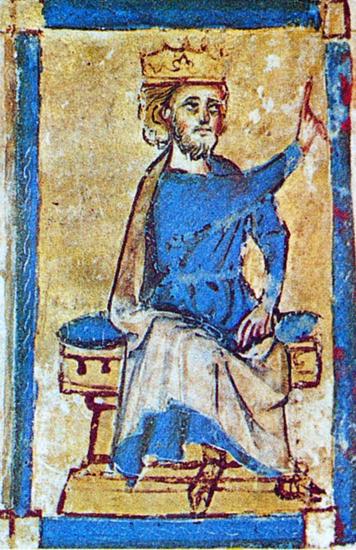by Susan Flantzer
© Unofficial Royalty 2025

Eric V, King of Denmark; Credit – Wikipedia
Eric V, King of Denmark reigned from 1259 to 1286. Born circa 1249, Eric V was the eldest of the five known children and the eldest and only surviving of the three sons of Christopher I, King of Denmark and Margrethe Sambiria. Eric V’s paternal grandparents were Valdemar II, King of Denmark and his second wife, Berengaria of Portugal. His maternal grandparents were Sambor II, Duke of Pomerania and Matilda of Mecklenburg.
Eric V had two younger brothers and two younger sisters:
Eric’s father, Christopher I, King of Denmark; Credit – Wikipedia
On May 29, 1259, in Ribe, Denmark, Eric’s father died at the age of forty, unexpectedly after taking Holy Communion. According to contemporary sources, he died after drinking poisoned communion wine from the hands of Abbot Arnfast of Ryd Abbey in revenge for his mistreatment of Archbishop Jacob Erlendsen and his oppression of the church. It is more likely that King Christopher I died from natural causes, but his supporters called him Krist-Offer, Christ’s sacrifice.

Eric’s mother, Margrethe Sambiria; Credit – Wikipedia
Eric V was only ten years old when his father died, and his mother, Dowager Queen Margrethe, served as regent until Eric’s maturity in 1264. This was unprecedented in Denmark. No queen or queen dowager, as far as it is known, had formally served as Regent of Denmark. During the regency, Margrethe had to raise an army and fight to keep her son on the throne from two powerful enemies, Archbishop Jacob Erlandsen and Erik Abelsøn, Duke of Schleswig, the son of King Abel of Denmark. On December 25, 1259, Erik V was crowned King of Denmark at Viborg Cathedral.
On November 11, 1273, King Eric V married Agnes of Brandenburg, the daughter of Johann I, Margrave of Brandenburg and his second wife Brigitte of Saxony. Eric and Agnes had seven children:
- Richeza of Denmark (circa 1272 – 1308), married Nicholas II, Lord of Werle, had two children
- Eric VI, King of Denmark (1274 – 1319), married Ingeborg Magnusdotter of Sweden, no surviving children, had eight sons who died as children and six miscarriages
- Christopher II, King of Denmark (1276 – 1332), married Euphemia of Pomerania, had six children
- Martha of Denmark (born between 1277 and 1282 – 1341), married Birger, King of Sweden, had six children
- Katharine of Denmark (circa 1281 – 1283), died in childhood
- Valdemar of Denmark (? – 1304), died in childhood
- Elisabeth of Denmark (1280 – 1283), died in childhood
King Eric V tried to enforce control over the church and nobility. In 1272, his conflict with the church was brought to a resolution with the help of Pope Gregory X. However, by 1282, Eric V had so offended the Danish nobles that he was forced to accept a charter, a kind of Danish Magna Carta, which limited his authority and guaranteed the rights and customs that preserved the nobles’ power. The charter forced King Eric to promise to hold annual meetings – the Danehof – a national assembly of “the best men of the realm”. King Eric V signed the charter, recognized as Denmark’s first-ever constitution, at Nyborg Castle in 1282.
Despite the progress with the nobles’ power, several nobles swore an oath to murder King Eric V in revenge for personal slights or unpopular policies. After a long hunt on November 22, 1286, led by Rane Jonsen, King Eric and his attendants could not find their way back to the king’s farm at Viborg. Rane suggested that they take shelter in the church barn in the village of Finderup. The assassins, dressed as Franciscan friars, were kept informed as to the king’s whereabouts and waited for everyone to settle down for the night. Once the king fell asleep, they rushed from their hiding places and stabbed and hacked the king to death. Tradition has it that he received 56 stab wounds. King Eric V was buried in Viborg Cathedral, where his grave is marked in the middle of the choir.

“The conspirators ride from Finderup after the murder of Eric Klipping St. Cecilia Night 1286” Painted by Otto Bache, 1882; Credit – Wikipedia
At the Danehof in Nyborg the following year, nine nobles were sentenced, of whom only one was accused of having killed the king. The others were accused of complicity. They all pleaded not guilty, but were condemned as outlaws, and they all fled to Norway, where they waited for a suitable opportunity to return. A few years later, the War of the Outlaws began when King Erik II of Norway and the convicted nobles carried out a number of successful attacks on Danish coastal towns and took control of Northern Jutland.
* * * * * * * * * *
This article is the intellectual property of Unofficial Royalty and is NOT TO BE COPIED, EDITED, OR POSTED IN ANY FORM ON ANOTHER WEBSITE under any circumstances. It is permissible to use a link that directs to Unofficial Royalty.
Works Cited
- Autoren der Wikimedia-Projekte. (2005). König von Dänemark (1259–1286). Wikipedia.org; Wikimedia Foundation, Inc. https://de.wikipedia.org/wiki/Erik_V._(D%C3%A4nemark)
- Bidragsydere til Wikimedia-projekter. (2004). Drabet på den danske konge Erik Klipping 1286. Wikipedia.org; Wikimedia Foundation, Inc. https://da.wikipedia.org/wiki/Mordet_i_Finderup_lade
- Bidragsydere til Wikimedia-projekter. (2003). Konge af Danmark (1249-1286). Wikipedia.org; Wikimedia Foundation, Inc. https://da.wikipedia.org/wiki/Erik_Klipping
- Eric V of Denmark. (2022). Wikipedia. https://en.wikipedia.org/wiki/Eric_V_of_Denmark
- Flantzer, Susan. (2025). Christopher I, King of Denmark [Review of Christopher I, King of Denmark]. Unofficial Royalty. https://www.unofficialroyalty.com/christopher-i-king-of-denmark/


